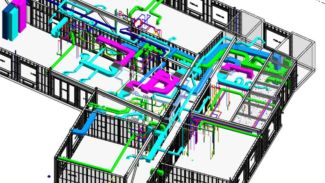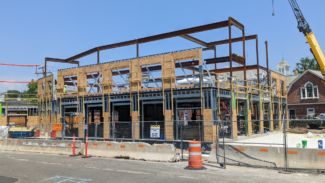Since C-shaped metal studs are asymmetrical, they have a weaker axis that needs to be reinforced. This is true for both load bearing and non-loading bearing walls. Metal stud bracing, or bridging, refers to the reinforcement of the framing to prevent buckling. The types of reinforcement vary with the type of framing.
Stud Bracing for Non-Load Bearing Walls
These types of walls may require top-of-wall bridging and bracing throughout the wall height, both of which are related to the idea of preventing the stud from twisting due to wind.
Top-of-wall bridging
For top-of-wall bridging, the top of stud needs to be braced against rotation. This is accomplished via through-knockout bridging (U-channel or spazzer bar) or flat strapping with blocking. These options have to occur within the top 12 inches of the stud. Alternatively, bridging can be avoided altogether with the use of a slotted deflection track.
Bridging along the height of the stud
In most cases, sheathing (such as gypsum or plywood,) on both faces of the wall eliminates the need for bridging throughout the height of the stud.
Do You Always Need Metal Stud Bracing?
Many architects and structural engineers use standard language and specifications. As an example, the specification resource, MasterSpec, will have boilerplate language that prescribes bracing at 4 feet on center. Iron Engineering is often able to eliminate this framing when it’s unnecessary in non-load bearing walls.
3 Types of Metal Stud Bracing
- Spazzer bar: These bent angle products run through the knockouts and engage the stud webs through slots at 12, 16, 24” on-center. This may only be used for studs that are 8” or smaller.
- Cold-rolled channel: This is a heavy-gauge channel shape that runs through the knockouts and is fastened to the studs using angles or proprietary clips.
- Continuous straps with blocking: This type of bracing is the least specific to a particular manufacturer. Continuous straps are used on both sides of a wall with a piece of track/stud blocking at 8 feet on-center.
Each type of bracing has its pros and cons and may come down to user preference.
Potential Complications & Challenges
There are a variety of complications that can surface during metal stud bracing. Here are some common ones we see:
- Knockouts that don’t align
- Interruptions at window jambs
- Too much/unnecessary bracing, which can be costly
These are just a few examples, but we encourage you to download our poster on this page to navigate the most common potential challenges and complications.
Questions About Metal Stud Bracing?
We provide specialized expertise in the design of cold-formed steel framing. Having worked as whole building structural engineers, we know what engineers and architects are looking for, and we have a vast amount of experience and knowledge when it comes metal stud bracing. If you have questions about our cold-formed steel services, or you’re looking for a quote for your next project, please contact us today. We look forward to answering your questions and learning how we can help.

